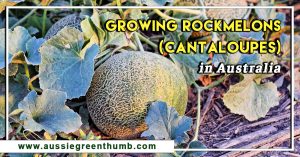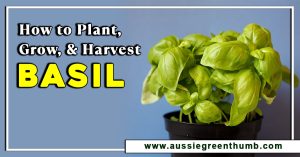Some plants look good, others have practical uses, and some are best known for their unique and confounding contribution to human history. The white mulberry, Morus alba, is definitely one of those.
Because the white mulberry is the sole natural food source of the silkworm, it is entirely responsible for the production of silk. The tree’s history in cultivation can be traced back over 4000 years to its native Chinas. Today, it is used both for its deliciously juicy fruits and for the production of natural silk.
Here, we’ll take a look through how you can grow it yourself (though, perhaps not on the scale of some commercial silk farms).
More...
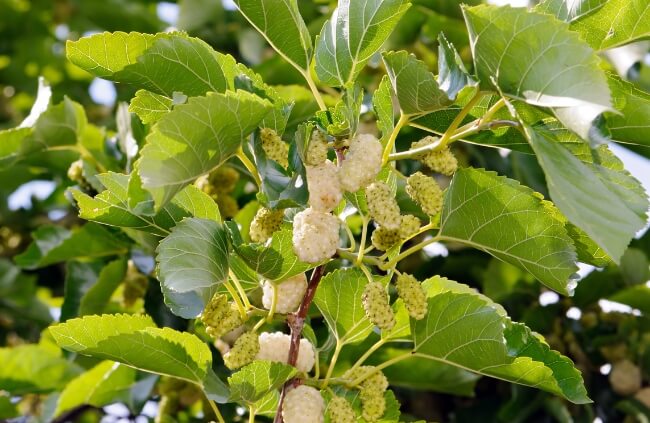
Family: | Moraceae |
|---|---|
Genus: | Morus |
Species: | M. alba |
Origin: | China and India |
Common Names: | white mulberry, common mulberry, silkworm mulberry |
Location: | Outdoor |
Type: | Small tree |
Growth: | 20m tall |
Sun requirements: | Full sun |
Foliage Colour: | Green |
Flower Colour: | Green and white |
Flowering: | Late spring and early summer |
Edible Parts: | Edible fruit, leaves, and young shoots |
Maintenance level: | Low-Medium |
Poisonous for pets: | Non-toxic to cats and dogs |
Getting to Know White Mulberry
Mulberry, just like raspberries, blackberries, apples and pretty much every other deliciously flavoured fruit, is a member of the same order of plants as roses – Rosales. However, it is part of a smaller family within that order, called Moraceae, which contains mulberries and figs.
The unusual plants typically grow as trees (though there are shrubs within the fig and mulberry genera).
White mulberry, also called the common mulberry, has the scientific name Morus alba. It grows as a small tree, with a maximum height of 20m, but more typically growing to 4-5m tall even when fully mature in most open landscapes.
There are multiple uses for mulberry trees, including in raising silkworm caterpillars and attracting silk moths. For most of us, it is the delicious mulberry fruits that make them worthy of space in our gardens.
Morus alba’s Natural Habitat
Morus alba is native to China and India, but is naturalised globally thanks to its cultivation and the popularity of silk throughout history – a material that relies entirely on white mulberry for its production (note: in some climates, osage orange leaves are used as an alternative).
Mulberry trees require rich, moisture-retentive soil to produce notable crops, but will survive in most soil conditions.
Uses for White Mulberry
White mulberry has two uses: food and sericulture (where it is also… food). However, there are a few notes about each that are worth remembering if you do intend to grow Morus alba in any productive capacity.
Edible Berries
Morus alba will produce bountiful crops of edible droops, compiled of distinctively sweet but sharp capsules. They look much like blackberries or raspberries.
The easiest way to harvest them is to wait until the majority of fruits are ripe and then place a sheet beneath the tree before vigorously shaking the trunk. Most will fall easily, and can be processed into jam or frozen for long-term storage (but we prefer to press them and turn them into a simple sweet wine).
Edible leaves
Mulberry leaf was used in traditional medicine to treat diabetes. Today, it is generally well respected as a supplementary support to relieve coughs and sore throats. Other potential uses for mulberry leaves are as a dietary aid to controlling weight gain.
The tea has some side effects, including bloating and nausea, and can be bought in powdered form, or brewed directly from fresh or dried leaves, picked at any time of year.


Get Your Free Guide:
Master Growing Australian Natives eBook
A Must Have Complete Guide for Every Australian Garden
Get Your Free Guide:
Master Growing Australian Natives eBook
A Must Have Complete Guide for Every Australian Garden
Silkworm Farming (Sericulture)
Silkworms feed on the leaves of mulberry bushes, and their moths are actively attracted to the trees. However, if you are trying to support natural habitats for silkworms won’t work. Sadly, there are no Bomby mori silkworms left in the wild, and the species of silkworms that are, are only native to India and parts of China.
Sericulture (silk farming) is possible in Australia, but no commercial silk farms have been successful in the past.
How to Grow White Mulberry Trees

Mulberry trees, including white mulberry, are short-lived trees, generally living for around 60-70 years before they stop being productive. In the wild, they are sometimes reported as 20-250 years old, but they will usually stop producing significant harvests after 60 years so will need replacing.
When planting your mulberry tree, it is worth giving it the best start possible and offering it soil that is easy to grow through and root into. Follow our guide below to offer the ideal conditions for young white mulberry trees to get established.
Ideal Conditions for Morus alba
Soil & Drainage
Mulberries, like most berries, like rich, loamy, moisture-retentive soil that drains reasonably well, but does not dry out completely.
This can be achieved easily in most gardens by adding garden compost, soil improver or well-rotted manure, regardless of the soil conditions you have.
If you have good loamy soil, adding nutrients from compost or manure will improve mulberry harvests. If you have poor drainage or low nutrients from clay or sandy soils, adding soil improvers, rotted manures or mature compost will help to improve soil structure and moisture retention, as well as feeding young plants.
Water and moisture requirements
Mulberries are produced through summer, and ripen either in late summer or early autumn depending on your climate. They require regular watering in warmer parts of Australia to ensure the best form and flavour.
Young trees should be drenched when you first plant them, followed by a generous mulch to prevent evaporation. For their first year, they are likely to need watering weekly.
Light and Position
Mulberry trees of all types can grow in partial shade, but the berries will ripen faster and with more sugar content if the plant is in full, bright, sunshine for at least 6 hours per day.
Their roots are tough so they should be planted at least 20 m away from concrete structures, pools or buildings.
Propagating White Mulberries
The most effective method of cultivating white mulberry is from seed. Cuttings are the most commonly advised method of propagating new plants from mature white mulberry trees, but in my experience, the results are highly unreliable.
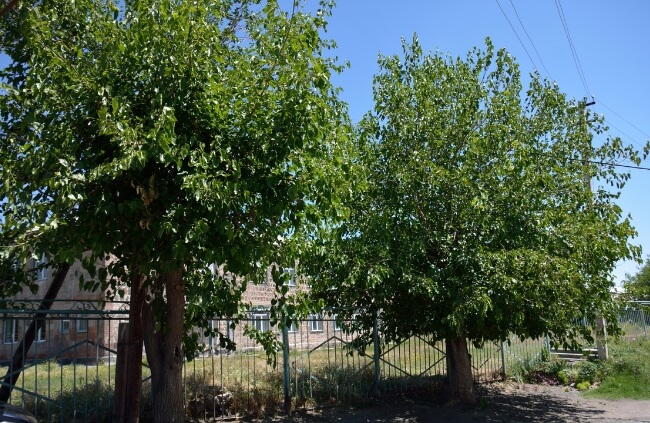
Propagating Morus alba from Seeds
With a brief period of cold stratifications (one month at 4°C or less in an open container in the fridge) the fresh seeds of mulberry trees have good germination rates, but it is important to use fresh seeds, rather than dried or processed seeds.
After cold stratifying mulberry seeds, sow them directly on the surface of a well-drained seed compost, or sieved leaf mould and perlite. Keep the soil moist by misting every few days.
Germination typically takes about four weeks after sowing.
Propagating White Mulberry from Cuttings
White mulberry trees will, theoretically, take from hardwood cuttings, simply by placing them in tranches and watering them in at the beginning of winter. This should trigger growth in spring, and if you are pruning your tree it's worth a go, but I have never personally had success with that method.
If you would like to give it a go, you’ll need some clean secateurs and a 30-40 cm piece of least year’s growth. Trim just below a node, and dip in rooting hormone to improve your odds.
Dig a spade into the ground, and wiggle to create a slit. Push your mulberry cutting into the slit, so half is buried, then water it well, and leave it alone until spring.
With a bit of luck, there should be signs of new growth in early spring, and the whole thing can be left there until it is strong enough to move.
How to Care for White Mulberries
White mulberries don’t take much looking after once they are established, but regular annual feeds and mulching do help boost fruiting and improve flavour. Potted white mulberries require a little bit more care, but will cope with restrictions surprisingly well.
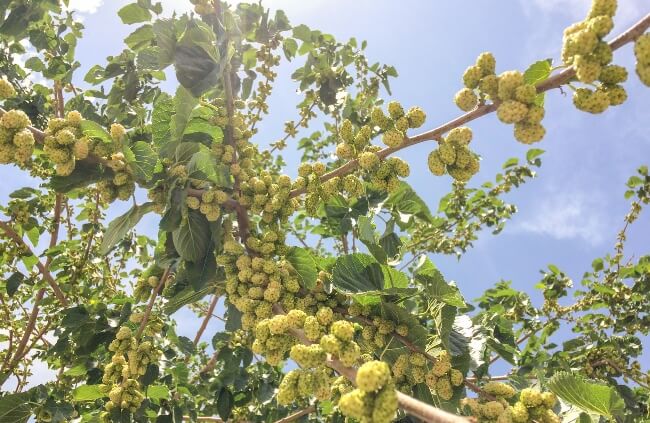
Mulching and Feeding Morus alba
A good quality, well-rotted, organic mulch is the most effective fertiliser for white mulberry trees. My preferred mulch for mulberry trees is well-rotted horse manure. It is simple, cheap, and incredibly effective at feeding nearly all varieties of soft fruit, mulberries included.
Like all trees, it is important to keep any mulch at least 10 cm away from the trunk around the base of the plant.
However, if you prefer not to mulch with heaps of steaming organic matter, there are some wonderful liquid and slow-release fruit-tree fertilisers available online, including our go-to liquid feed, Charlie Carp.
Water requirements of Morus alba
No matter how mature your white mulberry tree is, it will thank you for generous watering through summer. Don’t overdo it, and avoid watering if it’s rained, or the soil around the base of the tree is still moist.
If there has been any sort of drought or heatwave, it can negatively affect the developing fruit on white mulberries, so watering generously when needed will help to get your plants through the worst of summer.
Pruning Morus alba
Mulberry trees fruit from new growth. In most cases, young Morus alba trees won’t need any pruning, as the growth should be vigorous to support a generous crop, but after fifteen years, mulberry trees will slow down fruiting, and the canopy can become difficult to prune.
Pruning should be selective with the aim of an open canopy to encourage new growth in all directions.
Repotting Morus alba
Morus alba can be grown in pots, but it does restrict their growth. For a simple patio mulberry though, it is a perfectly good way of growing mulberry, and getting an interesting harvest from a small space.
Every two to three years, tip your white mulberry out of its pot and prune back its roots. If they begin to wrap around their container, prune the roots hard, and then pot on into a slightly larger pot with fresh compost.
Regularly prune the top growth to alternate points so that pruned roots can support each year’s fruit.
Morus alba Pests and Diseases
Caterpillars of all types are common pests on all mulberry trees, but there are no significant mulberry pests currently present in Australia, other than common garden pests like aphids, scale and spider mites.
Some web-spinning caterpillars can occur on white mulberry trees, and other caterpillar and moth species find the leaves particularly tasty – occasionally causing mass defoliation, but rarely with long-term consequences.
If pest problems persist on Morus alba, it can lead to fungal problems or bacterial infection, but on the whole, mulberries are well-built to cope with pests.
Diseases are less simple to define. Mulberry trees in Australia are commonly affected by growing issues, largely due to poor soil, drought and excessive drainage, but in some climates, the opposite is the case – where wet soils can cause root rot and encourage fungal issues around the base of the trunk.
In most cases, the first signs of any deficiency or disease in your mulberry tree will be weak growth and (typically) yellowing foliage.
If the problems are caused by nutrient deficiencies, mulch, mulch and mulch again, but if the soil is moist, and other plants are growing well nearby, it could be due to standing water causing root failure (either by saturation or due to fungal rot).
In both cases, dry the soil by aerating it with a fork, removing any mulch, and letting it dry out completely before watering with added fungicides like copper sulphate.
White Mulberry Frequently Asked Questions
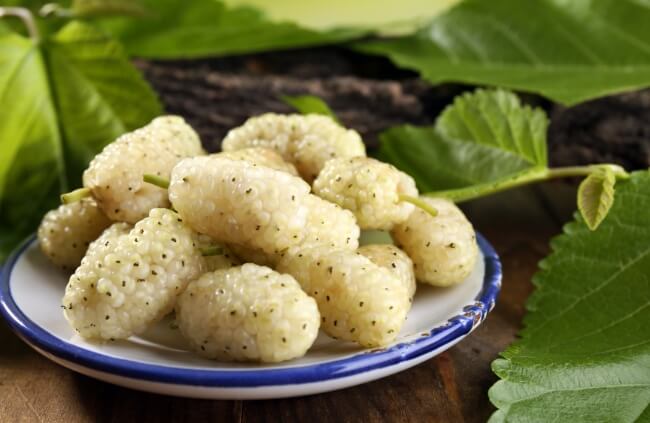
Are white mulberries good to eat?
White mulberries are a deliciously juicy source of fibre, rich in antioxidants and phytochemicals. Everything about the white mulberry is useful, but regardless of its potential health benefits, it tastes good, and that’s always the most important thing.
Are white mulberry trees rare?
The other name for white mulberry is ‘common mulberry’, so they are definitely not rare, but white mulberries are still less well known in domestic gardens than red mulberries, which makes a more attractive home-made jam.
What does white mulberry do to the skin?
White mulberry bark helps to reduce the visible effects of hyperpigmentation as it reduces the production of melanin thanks to a rich concentration of phenolic compounds. Melanin is responsible for tanning and dark spots on the skin.
Can you eat white mulberries raw?
While most people cook mulberries into jams and use them to brew and infuse wines and liquors, white mulberries can be eaten raw. They have a firm core, which is edible but has little flavour. This can be discarded or chewed.
Why don’t supermarkets sell mulberries?
Mulberries don’t last for more than four days once taken off the tree, even if refrigerated. They do freeze well but are generally not stocked in supermarkets because of their short shelf life, so if you want a steady supply of mulberries, planting your own tree is the only option.
Do mulberries taste like blackberries?
Mulberries have a rich winey flavour, not dissimilar to a deep, sugary, mulled red wine. But there is an undertone of citrus beneath their overall blend of raspberries and blackberries.
Is white mulberry invasive?
White mulberry is not an invasive species and does not outcompete Australian fauna. However, its roots can be invasive and damaging to property, so plant it at least 20 m away from free-standing structures.
Is mulberry leaf safe?
Mulberry leaf has no toxic effects reported, but for some mulberry tea drinkers, there are common side effects including bloating and nausea.
Enjoy the Benefits of Growing White Mulberry in Your Garden
From jams and jellies to skin-soothing remedies, the white mulberry has more secrets than most, but it is its history in the silk industry that sets this spectacularly beautiful fruiting tree apart from others, and makes it a wonderful specimen tree in gardens, whether potted, or in the ground.
White mulberries are easy to grow and productive. So, if you do choose to grow a white mulberry at home, you will be in good company, as they are becoming a much more popular tree, particularly for those of us interested in multi-purpose plants, with both ornamental and edible uses.
Published on January 10, 2024 by Maisie Blevins
Last Updated on September 20, 2024

